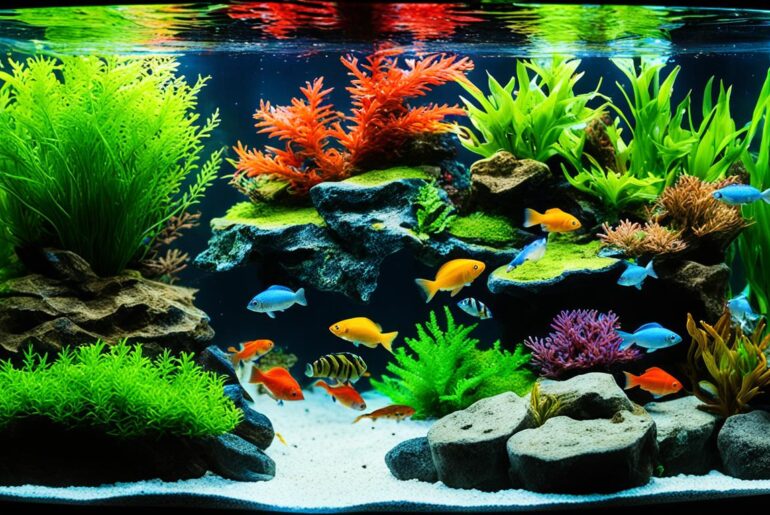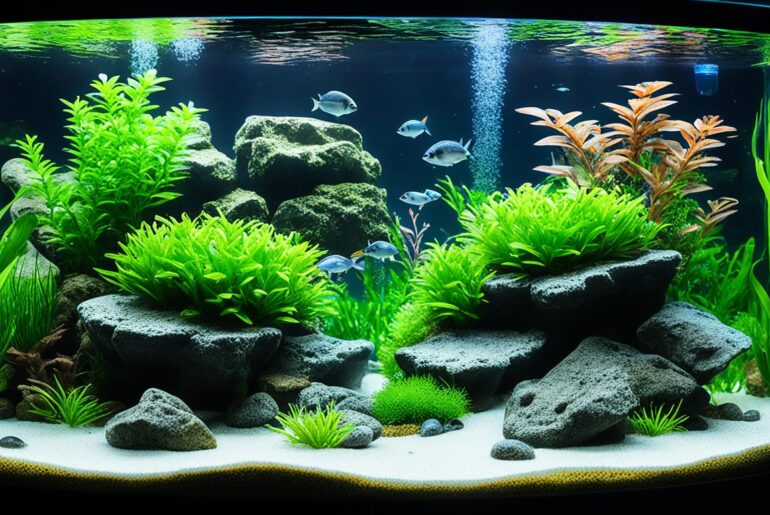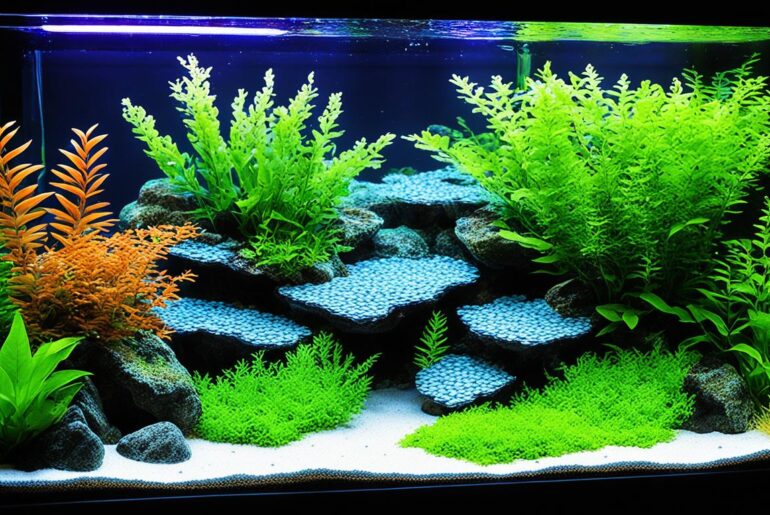Have you ever walked into a room and been instantly captivated by the mesmerizing beauty of a freshwater tank? The tranquil world it holds, with its colorful fish and vibrant plants, has a magical way of soothing the soul. But as any aquarium enthusiast knows, maintaining that beauty requires diligent effort and care.
I remember the first time I set up my freshwater tank. It was a labor of love, carefully selecting each fish and meticulously arranging the plants and decorations. However, my joy was soon overshadowed by the relentless invasion of algae. The once-clear glass was now covered in a slimy green film, obscuring the view of my beloved aquatic friends.
With frustration mounting, I sought advice from experts and fellow hobbyists. Through their guidance and my own trial and error, I discovered three key tips that have been instrumental in preventing algae growth in my freshwater tank. I want to share these tips with you so that you too can maintain a clean and healthy aquarium, free from the clutches of algae.
Key Takeaways:
- Algae growth in freshwater tanks is a common issue.
- With proper prevention methods, you can maintain a clean and healthy aquarium.
- Choosing the right fish size, managing lighting, and maintaining water quality are key factors in preventing algae growth.
- Regular maintenance, water changes, and monitoring are essential for algae prevention.
- Understanding the different types of algae will help you address specific algae issues effectively.
What Causes Algae in a Fish Tank?
Algae growth in fish tanks is a natural occurrence driven by three key factors: water, nutrients, and light. Understanding the causes of algae growth can help you take proactive steps to prevent it from becoming a nuisance in your tank.
Excess Nutrients
Excess nutrients, such as nitrates and phosphates, act as fuel for algae growth. These nutrients can enter your fish tank through various sources, including fish waste, uneaten food, decaying plants, and tap water. If left unchecked, an abundance of nutrients can create an ideal environment for algae to thrive.
Prolonged Exposure to Light
Light plays a critical role in photosynthesis, a process in which algae convert light energy into chemical energy. While some light exposure is necessary for plant and fish health, prolonged and unregulated light can stimulate excessive algae growth. Extended periods of light without proper rest periods can lead to imbalances in the tank’s ecosystem.
Lack of Proper Tank Maintenance
Inadequate tank maintenance can contribute to algae overgrowth. If you neglect regular water changes, fail to clean the tank, or allow debris to accumulate, it creates a favorable environment for algae to multiply. Maintaining a clean tank and healthy ecosystem is crucial in preventing algae issues.
“Excess nutrients, prolonged exposure to light, and lack of proper tank maintenance can contribute to algae overgrowth.”
By addressing these factors and implementing preventative measures, you can control algae growth in your fish tank and maintain a healthy aquatic environment for your fish.
| Causes | Effects | Preventive Measures |
|---|---|---|
| Excess nutrients | – Promotes rapid algae growth – Higher risk of imbalances in water parameters |
– Regular water changes – Proper filtration – Controlled feeding |
| Prolonged exposure to light | – Stimulates excessive algae growth – Imbalances in light-dependent processes |
– Use a timer for consistent light cycles – Provide shade or reduce direct sunlight exposure |
| Lack of proper tank maintenance | – Allows debris and organic matter to accumulate – Creates an unbalanced ecosystem |
– Regular cleaning and maintenance routines – Remove uneaten food and waste |
By understanding what causes algae growth in a fish tank and actively managing these factors, you can create a well-balanced and algae-free environment for your fish to thrive.
Why Do I Need to Remove Algae?
While a small amount of algae is a sign of a healthy tank, excessive algae growth can have detrimental effects. Algae can increase the pH level in the tank, causing chemical burns on fish. It can also lead to oxygen fluctuations, potentially suffocating fish. Regular removal of algae is necessary to maintain a clean and safe environment for your fish.
Excess algae in the tank can disrupt the delicate balance of the ecosystem. As algae multiply, they consume more oxygen during the process of photosynthesis. This can lead to fluctuations in oxygen levels, potentially suffocating fish and other aquatic organisms. Removing algae helps regulate oxygen levels in the tank, ensuring the well-being of your fish.
Furthermore, excessive algae growth can elevate the pH level in the tank. High pH levels can cause chemical burns on the fish’s skin, leading to discomfort and stress. In severe cases, these burns can lead to infections and other health issues. Removing algae helps prevent these harmful effects and maintains a healthy environment for your fish.
Regular maintenance and algae removal also improve the overall aesthetics of your fish tank. Excessive algae can make the tank look dirty and unkempt, impairing the visual appeal of your aquarium. By removing algae, you can enhance the beauty of your tank and create a visually pleasing environment for both yourself and your fish.
“Regular removal of algae is necessary to maintain a clean and safe environment for your fish.”
By understanding the reasons to remove algae and taking proactive steps to control its growth, you can ensure the health and well-being of your fish. In the next section, we will explore the potential harm algae can cause to fish and why it is crucial to address algae growth promptly.

Can Algae Kill Fish?
Small amounts of algae are generally not harmful to fish. However, if left unchecked, excessive algae growth can have negative effects on fish health.
Algae can increase the pH levels in the tank, leading to chemical burns on fish. This compromises their natural defense against bacteria and parasites, making them more susceptible to infections and diseases. Additionally, algae blooms can deplete oxygen levels in the tank, suffocating the fish and causing distress.
“Excessive algae growth can have detrimental effects on fish health, including chemical burns and oxygen depletion.”
It is crucial to control algae growth in order to ensure the well-being of your fish. Regular maintenance and proper tank care are essential for preventing excessive algae growth and maintaining a healthy aquatic environment.
Let’s take a closer look at the dangers associated with algae in fish tanks:
The Dangers of Algae in Fish Tanks:
| Issue | Danger |
|---|---|
| Increased pH levels | Chemical burns on fish, compromising their defense against bacteria and parasites. |
| Oxygen depletion | Suffocating fish and causing distress. |
As seen in the table above, algae can have significant detrimental effects on fish health if not properly managed.
Proactive measures to prevent algae growth, such as maintaining proper lighting, controlling nutrient levels, and regular tank maintenance, are crucial for creating a safe and healthy environment for your aquatic pets.
Tip 1 – Get The Right Size Fish
The size of the fish in your tank can have a significant impact on algae growth. When choosing fish for your aquarium, it’s important to consider their size and how it may affect the overall balance of your tank. Larger fish tend to produce more waste, which can lead to increased bacteria and algae production.
To prevent overcrowding and excessive waste, it’s crucial to select fish that are appropriate for the size of your tank. Research the adult size of the fish species you are interested in and ensure they have enough space to swim comfortably. This will help to minimize algae growth and maintain a healthier environment for your fish.
Here are a few things to keep in mind when choosing the right size fish:
- Consider the dimensions of your tank and the swimming habits of the fish species you want to keep. Some fish require more horizontal swimming space, while others prefer vertically oriented tanks.
- Pay attention to the recommended tank size for each fish species. This information is usually available on reputable aquarium websites or from knowledgeable fishkeepers.
- Ensure compatibility between different fish species based on their sizes and temperaments. Some fish may be more aggressive and not suitable tank mates for smaller or more docile species.
By carefully selecting fish that are the right size for your tank and compatible with each other, you can help prevent overcrowding, minimize waste, and reduce the conditions that promote algae growth.
Tip 2 – Manage Lighting
Managing the lighting in your fish tank is crucial for controlling algae growth. Light is a major factor that contributes to the development of algae, so it’s essential to implement proper lighting strategies. By following the tips below, you can effectively prevent algae and maintain a clean and healthy aquarium.
Limit Light Duration
One of the key steps in managing lighting is to limit the duration of light exposure in your fish tank. Excessive light can promote algae growth, so it’s important to give your tank a proper light-dark cycle. Use a timer to set the duration of light to 8-10 hours per day. This simulates natural day and night cycles, helping to regulate algae growth.
Avoid Direct Sunlight
Direct sunlight can also contribute to algae overgrowth in your fish tank. It’s crucial to place your tank away from direct sunlight to prevent excessive light exposure. Sunlight provides an abundance of light and heat, creating favorable conditions for algae growth. Keeping your tank in a shaded area or using aquarium lighting instead of natural sunlight can help control algae development.
Utilize Proper Lighting Equipment
The type of lighting equipment you use can also affect algae growth in your fish tank. LED lights are highly recommended as they provide a balance between sufficient light for your aquatic plants and fish while minimizing algae growth. LED lights consume less energy, produce less heat, and have a longer lifespan compared to traditional fluorescent lights. Choose a lighting system that provides the appropriate intensity and spectrum for your tank’s inhabitants.
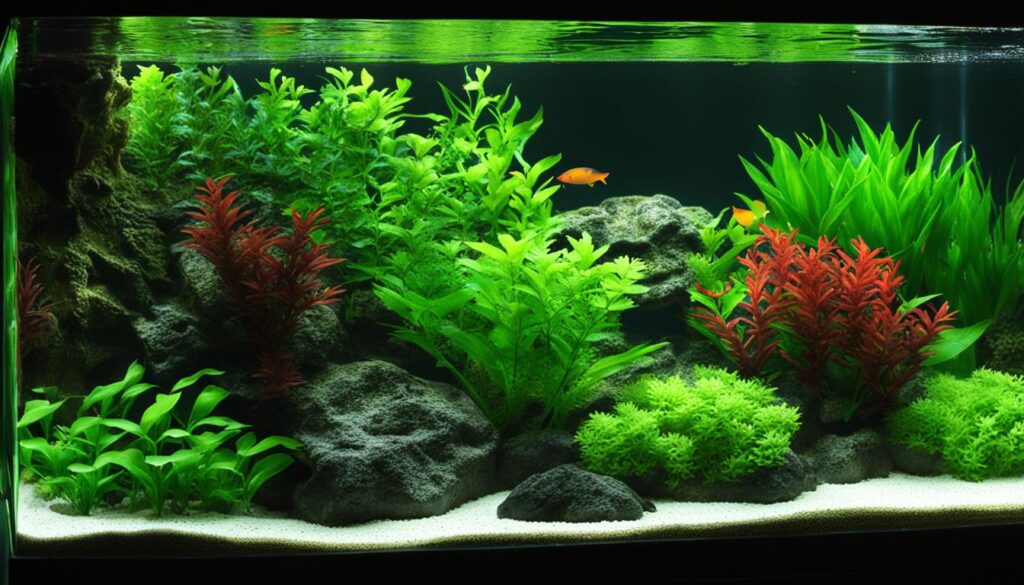
Expert Advice: “Properly managing the lighting in your fish tank is crucial for preventing algae growth. By limiting light duration, avoiding direct sunlight, and utilizing the right lighting equipment, you can maintain a clean and healthy aquatic environment for your fish and plants.”
Implementing these tips will help you control algae growth in your fish tank by effectively managing the lighting. By establishing a balanced light-dark cycle, avoiding direct sunlight, and using appropriate lighting equipment, you can create an environment that discourages algae development. Remember, maintaining the right lighting conditions is key to a thriving aquarium.
Tip 3 – Maintain Water Quality
Ensuring the quality of water in your fish tank is essential for preventing algae growth. By regularly cleaning the tank and maintaining proper water parameters, you can create a healthy environment for your fish while keeping algae at bay.
Perform Regular Water Changes
Regular water changes are crucial for maintaining water quality in your fish tank. They help remove excess nutrients that can fuel algae growth and replenish essential minerals for your fish’s health. Aim to change approximately 25% of the water every two weeks to keep the water fresh and clean.
Clean the Tank and Remove Algae
Cleaning the tank and removing algae buildup are key tasks for preventing algae growth. Use a sponge or algae scraper to gently remove algae from the glass and decor of the tank. Be careful not to disturb or harm any fish or plants in the process. Additionally, clean the tank’s filter regularly to ensure proper water circulation and filtration.
“Regular water changes and proper tank cleaning are vital for maintaining a clean and healthy living environment for your fish.”
Monitor Water Parameters
To prevent algae growth, it’s important to monitor and maintain proper water parameters in your fish tank. Test the water regularly for pH, ammonia, nitrite, and nitrate levels to ensure they are within the appropriate range for your fish species. Use appropriate water treatments, if necessary, to adjust these parameters and keep your tank’s water quality in check.
Use Quality Water Sources
The quality of the water you use to fill your fish tank can also impact algae growth. Use dechlorinated water or a high-quality water conditioner to remove harmful chemicals, such as chlorine or chloramine, that can promote algae growth. Avoid using tap water that contains excessive phosphates or nitrates, as they can contribute to algae overgrowth.
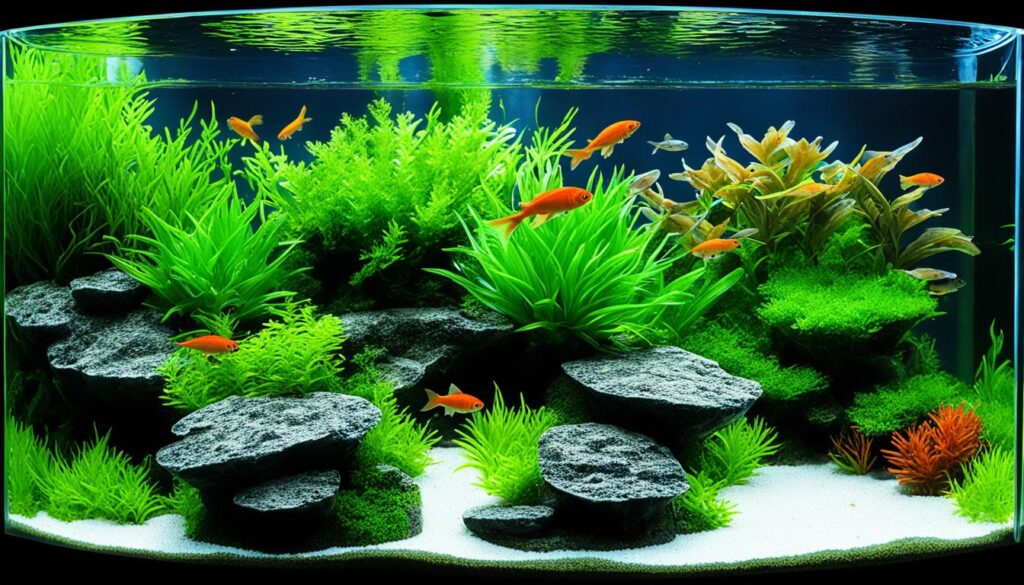
| Water Quality Tips for Algae Prevention |
|---|
| Perform regular water changes |
| Clean the tank and remove algae buildup |
| Monitor water parameters |
| Use quality water sources |
Additional Tips for Algae Prevention
In addition to the key tips mentioned above, there are other practices you can implement to prevent algae in your freshwater tank.
1. Placing the tank away from direct sunlight: Sunlight can promote algae growth in your tank. Positioning it in a shaded area or using curtains to block direct sunlight can help prevent excessive algae growth.
2. Using live plants to absorb excess nutrients: Live plants not only enhance the aesthetics of your tank but also help in reducing excess nutrients that contribute to algae growth. Plants absorb nutrients like nitrates and phosphates, making them less available for algae to thrive.
3. Introducing algae-eating fish: There are various species of fish known for their ability to eat algae. Adding these fish to your tank can provide a natural solution for keeping algae growth under control. Examples include Siamese algae eaters, otocinclus catfish, and plecos.
4. Testing your water source for high levels of phosphates and nitrates: Phosphates and nitrates are nutrients that promote algae growth. Testing your water source will help you identify if these levels are high, indicating the need for appropriate treatments to reduce their presence.
5. Using appropriate treatments: If your water source has high levels of phosphates and nitrates, using treatments specifically designed to reduce these nutrients can help prevent algae growth. Follow the instructions provided by the manufacturer and regularly monitor the water parameters to ensure effectiveness.
Implementing these additional tips, along with the key tips mentioned earlier, will significantly contribute to preventing algae growth and maintaining a clean and healthy freshwater tank.
Note: It is essential to monitor the health and behavior of your fish when introducing algae-eating fish or using any treatments. Some fish species may have specific requirements or sensitivities that need to be taken into consideration.

| Tips | Description |
|---|---|
| Placing the tank away from direct sunlight | Prevents excessive algae growth by minimizing light exposure |
| Using live plants to absorb excess nutrients | Reduces nutrients like nitrates and phosphates, limiting algae food source |
| Introducing algae-eating fish | Provides a natural solution for controlling algae growth |
| Testing water source for high levels of phosphates and nitrates | Identifies the need for treatments to reduce nutrient levels |
| Using appropriate treatments | Targets and reduces specific nutrients promoting algae growth |
Dealing with Different Types of Algae
Different types of algae can be found in fish tanks, and each requires a specific approach for effective management and control. Understanding the characteristics of these algae types will help you address algae issues more efficiently.
Brown Algae
Brown algae, also known as diatoms, are common in new fish tanks. They appear as a brownish coating on the tank surfaces and decorations. Luckily, brown algae can be easily wiped off with a soft cloth or sponge. Regular tank maintenance, including cleaning and water changes, will help prevent the growth of brown algae.
Blue-Green Algae (Cyanobacteria)
Blue-green algae, or cyanobacteria, can be challenging to control in fish tanks. They commonly appear as slimy green or blue-green mats on the substrate, rocks, and decorations. Cyanobacteria thrive in low-nutrient and low-flow environments. To manage blue-green algae, it’s crucial to maintain proper water flow, perform regular water changes, and promptly remove any visible algae. In severe cases, special treatments may be necessary to effectively eliminate cyanobacteria.
Red or Beard Algae
Red or beard algae are tough and often grow on plants, rocks, and other tank surfaces. They have a fuzzy appearance and can range in color from green to red. Red algae can be challenging to remove and require a more targeted approach. Proper tank care, including regular water changes, maintaining optimal water parameters, and manually removing infected plants or surfaces, can help control and reduce the growth of red algae.
Green Algae
Green algae are the most common type of algae found in fish tanks. They can appear as a slimy coating on tank surfaces, in the water column, or as free-floating algae. Green algae can be managed by maintaining proper tank care practices, such as regular cleaning, water changes, and the introduction of algae-eating fish, like certain species of plecos or Siamese algae eaters. Balanced lighting and nutrient levels are also important for controlling green algae growth.

Each type of algae requires a specific management approach. By identifying and understanding the different types of algae in your fish tank, you can implement targeted strategies and prevent excessive growth. Remember to regularly monitor your tank, perform necessary maintenance, and ensure proper water parameters to maintain a clean and healthy aquarium environment.
Conclusion
Preventing algae in freshwater tanks is essential for maintaining a clean and healthy environment for your fish. By implementing the tips shared in this article, such as choosing appropriate fish sizes, managing lighting, and maintaining water quality, you can effectively control algae growth. Regular maintenance, including water changes and monitoring, will contribute to a thriving aquarium.
Remember to consider the size of your fish in relation to your tank capacity to prevent overcrowding and excessive waste production. Managing the lighting duration and avoiding direct sunlight exposure will help minimize algae growth. Additionally, regular water changes and proper cleaning will maintain water quality, preventing excess nutrients that encourage algae development.
By following these practices, you can enjoy the beauty of a clean and healthy freshwater tank, while keeping algae at bay. Your fish will thrive in a well-maintained environment, enhancing their overall health and well-being. Implement these strategies, and enjoy the beauty and tranquility of your algae-free aquatic oasis.
FAQ
What are some key tips for algae prevention in freshwater tanks?
The key tips for algae prevention in freshwater tanks are choosing appropriate fish size, managing lighting, and maintaining water quality.
What causes algae in a fish tank?
Algae in fish tanks is caused by factors such as excess nutrients, prolonged exposure to light, and lack of proper tank maintenance.
Why do I need to remove algae?
Regular removal of algae is necessary to maintain a clean and safe environment for your fish and to prevent negative effects such as high pH levels and oxygen fluctuations.
Can algae harm fish?
While small amounts of algae are generally not harmful to fish, excessive algae growth can have negative effects such as high pH levels causing chemical burns on fish, and algae blooms depleting oxygen levels in the tank, potentially suffocating fish.
How can I prevent algae with fish selection?
Choosing the right size fish for your tank can help minimize algae growth as larger fish produce more waste, leading to increased bacteria and algae production.
How can I prevent algae with proper lighting?
Managing the lighting in your tank by limiting the duration of light to 8-10 hours per day and avoiding direct sunlight can help control algae growth.
How can I maintain water quality to prevent algae?
Regular maintenance and water quality management are crucial for algae prevention. This includes performing regular water changes, cleaning the tank, and removing algae from the glass and decor. Properly monitoring and maintaining water parameters is also essential.
What are some additional tips for algae prevention?
In addition to the key tips mentioned, you can also place the tank away from direct sunlight, use live plants to absorb excess nutrients, introduce algae-eating fish, test your water source for high levels of phosphates and nitrates, and use appropriate treatments.
How can I deal with different types of algae?
Different types of algae require different approaches for removal and control. Brown algae can be easily wiped off, blue-green algae may require special treatments, red or beard algae can be tough to remove and often grow on plants, and green algae can be managed with proper tank care and the introduction of algae-eating fish.
What are some key points for maintaining a clean and healthy freshwater tank?
By implementing the tips discussed above, such as choosing appropriate fish size, managing lighting, and maintaining water quality, you can prevent and control algae growth, ensuring a clean and healthy environment for your fish.

